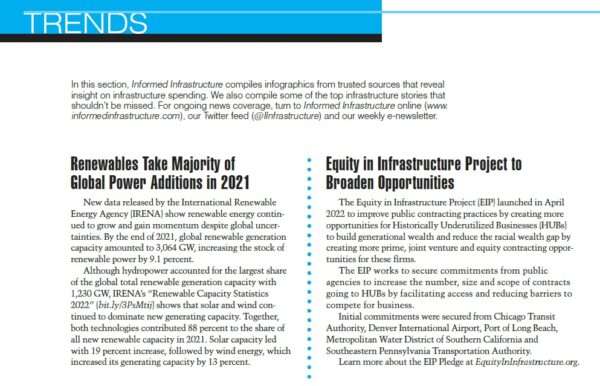June 2022 Trends

In this section, Informed Infrastructure compiles infographics from trusted sources that reveal insight on infrastructure spending. We also compile some of the top infrastructure stories that shouldn’t be missed. For ongoing news coverage, turn to Informed Infrastructure online (www.informedinfrastructure.com), our Twitter feed (@IInfrastructure) and our weekly e-newsletter.
Renewables Take Majority of Global Power Additions in 2021
New data released by the International Renewable Energy Agency (IRENA) show renewable energy continued to grow and gain momentum despite global uncertainties. By the end of 2021, global renewable generation capacity amounted to 3,064 GW, increasing the stock of renewable power by 9.1 percent.
Although hydropower accounted for the largest share of the global total renewable generation capacity with 1,230 GW, IRENA’s “Renewable Capacity Statistics 2022” (bit.ly/3PsMtij) shows that solar and wind continued to dominate new generating capacity. Together, both technologies contributed 88 percent to the share of all new renewable capacity in 2021. Solar capacity led with 19 percent increase, followed by wind energy, which increased its generating capacity by 13 percent.
Equity in Infrastructure Project to Broaden Opportunities
The Equity in Infrastructure Project (EIP) launched in April 2022 to improve public contracting practices by creating more opportunities for Historically Underutilized Businesses (HUBs) to build generational wealth and reduce the racial wealth gap by creating more prime, joint venture and equity contracting opportunities for these firms.
The EIP works to secure commitments from public agencies to increase the number, size and scope of contracts going to HUBs by facilitating access and reducing barriers to compete for business.
Initial commitments were secured from Chicago Transit Authority, Denver International Airport, Port of Long Beach, Metropolitan Water District of Southern California and Southeastern Pennsylvania Transportation Authority.
Learn more about the EIP Pledge at EquityInInfrastructure.org.
New ASCE Publication Explores Emerging Technologies
Disruptive technology changes the way things are done, and the “Fourth Industrial Revolution (4IR)” is doing just that, occurring exponentially and affecting almost every industry, including transportation. Emerging technologies such as Internet of Things (IoT), 5G wireless technologies, artificial intelligence, robotics, and connected and automated vehicles (CAVs) offer great potential to mitigate existing transportation issues and will affect many aspects of education and workforce development in coming years.
The latest American Society of Civil Engineers (ASCE) publication, Disruptive Emerging Transportation Technologies, addresses the need to bring critical, fundamental understanding of relevant disruptive emerging technologies and their potential impacts on smart transportation infrastructure and systems.
To purchase online, visit the ASCE Bookstore at bit.ly/3MjoG2v.
Survey Reveals Investments in Sustainability Rebounded to Pre-Pandemic Levels, Challenges Remain
Johnson Controls announced findings from its “15th Annual Energy Efficiency Indicator Survey,” which revealed that 62 percent of organizations surveyed expect to increase investments in energy efficiency, renewable energy or smart building technology in 2022, indicating a return to pre-pandemic levels.
The latest report by the United Nations Intergovernmental Panel on Climate Change advised that global-scale transformation is urgently needed to combat climate change, but the Energy Efficiency Indicator Survey found that organizations are still facing challenges to accelerate their sustainability efforts in key areas. Almost two-thirds of survey respondents say they struggle to scale sustainability initiatives across buildings, geographies or business units.
The survey revealed that actionable policies are important to reach energy-efficiency goals, with 85 and 72 percent of respondents, respectively, reporting that performance benchmarking/certifications and performance standards for energy codes are critical to improving energy-efficiency efforts.
To learn more about the survey findings, visit www.johnsoncontrols.com/2021EEI.
The U.S. Department of Transportation (DOT) opened the application process for communities of all sizes to apply for $1 billion in fiscal year 2022 funding to help them ensure safe streets and roads for all and address the national roadway safety crisis. The Bipartisan Infrastructure Law’s new Safe Streets and Roads for All (SS4A) discretionary grant program provides dedicated funding to support regional, local and Tribal plans, projects and strategies that will prevent roadway deaths and serious injuries.
Applications may come from individual communities or groups of communities and may include Metropolitan Planning Organizations (MPOs), counties, cities, towns, other special districts that are subdivisions of a state, certain transit agencies, federally recognized Tribal governments and multi-jurisdictional groups.
The Safe Streets for All Notice of Funding Opportunity can be found at www.transportation.gov/SS4A. Applications are due on or before Sept. 15, 2022.
In addition, the Department of the Interior announced an investment of $240.4 million for infrastructure repairs in fiscal year 2022 from the Bipartisan Infrastructure Law. The program, facilitated through the Bureau of Reclamation, includes significant repairs on canal linings, dam spillways and water pipeline replacements.
Among the 46 projects selected for funding in 2022 are large projects to conduct canal repairs in Arizona, California, Idaho, Nevada and Wyoming; dam spillway repairs in Kansas; pipeline repairs in Utah; and investments in a pumping plant in Montana. Projects in Colorado, Oregon and Washington also are being funded. The 46 projects to be funded can be viewed on Reclamation’s website at on.doi.gov/3ldwcQH.
TOP Stories
The following are the top stories from the last few months (in terms of traffic) on the Informed Infrastructure website. This also reflects key coverage areas that are regularly refreshed online and via our weekly e-newsletter. Simply search key words on Informed Infrastructure online to find the full story.
Buildings
- Community Leaders Celebrate Groundbreaking of Astra Tower, Soon To Be Utah’s Tallest High-Rise
- Video: Concrete Climate Ideas: Girl Scouts Talk Building Materials and Embodied Carbon
- ASCE Standard 49 Provides the Most Up-To-Date Requirements for Conducting and Interpreting Wind Tunnel Testing
- New ASCE Standard 72 Provides Design Guidance for Self-Supporting Structures
- American Concrete Institute Releases New Repair Code
Transportation
- President Biden, U.S. Department of Transportation Releases Toolkit to Help Rural Communities Build Out Electric Vehicle Charging Infrastructure
- Video: MDOT Transportation Diversity Recruitment Program
- Jacobs to Design First Inductive Charging Project on a U.S. Public Road
- Philippine National Railways Modernizes Communication System For Improved Work Efficiency
- Study: Transit-Oriented Development Can Save Money
Water
- STAR Water Becomes 1st BREW Company to Go Public
- Suppliers Partnership for the Environment (SP) Collaborates with The Water Council (TWC) to Advance Water Stewardship in the Automotive Supply Chain
- AMI Infrastructure: From Water Meters to Business Intelligence
- ENGEO to Design World’s First GHAD to Prevent Flooding and Levee Failure
- New ASCE Publication Applies Renewable Energy Technologies to Existing Water Infrastructure
Tools and Technology
- SurvTech Using SimActive Software for Energy Infrastructure Projects
- New Leica AP20 AutoPole—The World’s First Tilt-Compensated Total Station Pole Solution for Construction and Surveying Professionals
- COBOD Releases the World’s First 3D Construction Printer Configurator
- Damen Shipyards Uses Matterport Digital Twins to Accelerate Workflow and Enhance the Customer Experience
- Digital Twin Consortium Announces Capabilities Periodic Table Framework


